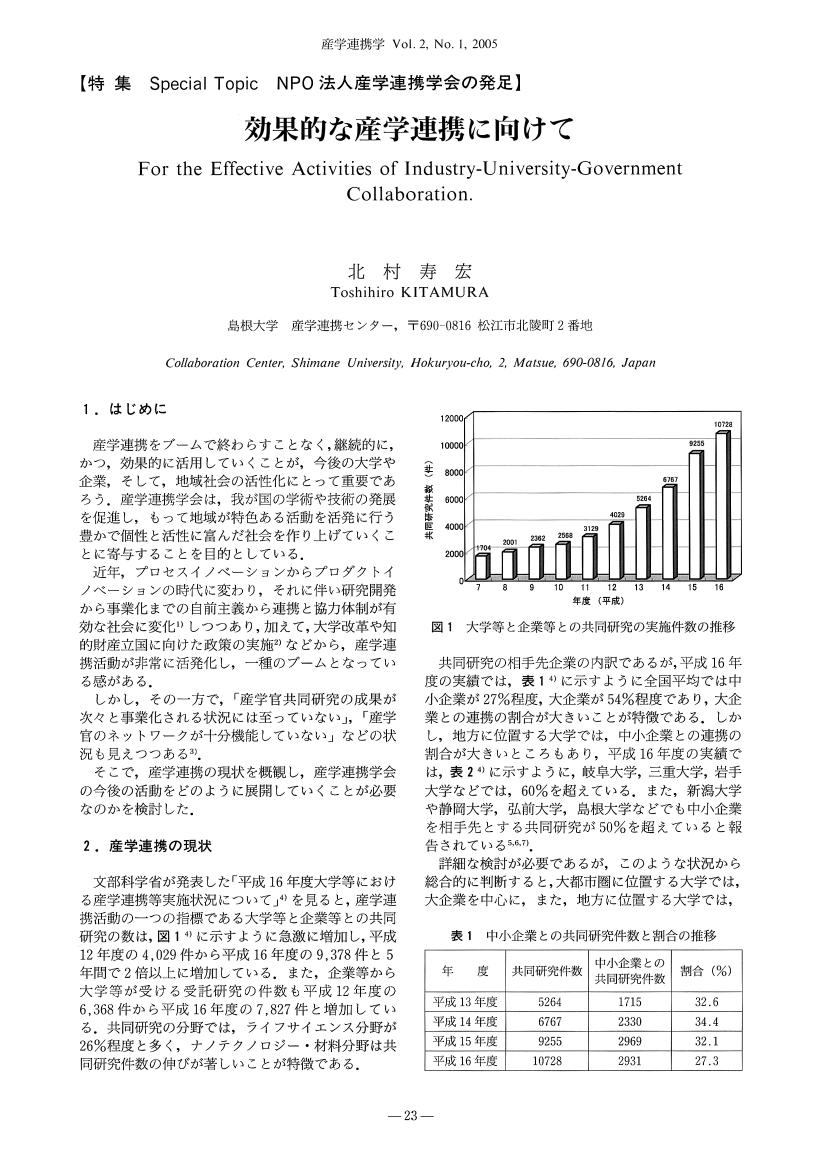2 0 0 0 OA 都道府県別の特許出願件数の推移からみた企業の研究・開発活動の活発さの概況
- 著者
- 北村 寿宏 丹生 晃隆 藤原 貴典 川崎 一正 伊藤 正実
- 出版者
- 特定非営利活動法人 産学連携学会
- 雑誌
- 産学連携学 (ISSN:13496913)
- 巻号頁・発行日
- vol.10, no.2, pp.2_32-2_41, 2014 (Released:2014-07-02)
- 参考文献数
- 13
各都道府県における企業の研究・開発活動の活発さを検討するために,特許出願件数の推移を調査した.その結果,特許出願件数は2000~2012年の13年間を通し,ほとんどの都道府県で減少傾向にあることが分かった.大都市圏や大規模大学を有する地域以外の各県においては,各県における特許出願件数とそこに位置する国立大学における企業を相手先とする共同研究の件数の間に緩やかな相関があることがわかった.特に,北東北や山陰,四国,九州に位置する各県の多くでは,他の都道府県に比べて,当該県における特許出願件数が少なく,そこに位置する国立大学においては企業を相手先とする共同研究の件数が少ない傾向にあることが明らかになった.この結果は,これらの地域では企業だけでなく当該地域に位置する大学を含めた地域の研究・開発活動の活発さが弱いことを示唆している.地域イノベーションの創出の観点からは,これらの地域では特に研究・開発力の向上に向けて,今後,地域の状況に応じた対策が必要であると考えられる.
1 0 0 0 OA 島根大学における産学連携活動の現状と今後の方向性
- 著者
- 北村 寿宏
- 出版者
- 特定非営利活動法人 産学連携学会
- 雑誌
- 産学連携学 (ISSN:13496913)
- 巻号頁・発行日
- vol.1, no.1, pp.34-39, 2004 (Released:2005-05-13)
- 参考文献数
- 4
- 被引用文献数
- 7
島根大学 (旧) における産学連携活動の現状を分析しその特徴を明らかにすると共に, 現在の問題点を明確にし, 今後の産学連携活動の方向性について検討した.(1) 産学連携の主な相手先は, 島根県内の中小企業であり, 産学連携活動の特徴は, 大学の位置する地域に根ざした「県内展開中心型」である.(2) 産学連携活動における全般的な問題点としては, 比較的小規模な研究が多い, 実施する研究者と企業とも固定化されつつある, 文系の共同研究が少ない, の3つが挙げられる.(3) 産学連携活動の特徴を活かし, かつ, 問題点を解決し, 活動を活発化させ成果を上げていくためには, 地域社会と一体となった活動に重点化し, 地域の活動から全国, 全世界の活動に広げていくという方向性が有効と考えられる.
1 0 0 0 OA 効果的な産学連携に向けて
- 著者
- 北村 寿宏
- 出版者
- 特定非営利活動法人 産学連携学会
- 雑誌
- 産学連携学 (ISSN:13496913)
- 巻号頁・発行日
- vol.2, no.1, pp.23-25, 2005 (Released:2006-01-20)
- 参考文献数
- 10
1 0 0 0 OA 国立大学における共同研究件数の推移から見る産学連携の実状と課題
- 著者
- 北村 寿宏
- 出版者
- 特定非営利活動法人 産学連携学会
- 雑誌
- 産学連携学 (ISSN:13496913)
- 巻号頁・発行日
- vol.8, no.1, pp.1_39-1_46, 2011 (Released:2012-01-12)
- 参考文献数
- 13
国立大学における産学連携の実状を明確にするために,共同研究件数の推移について調査した. 共同研究件数で比較すると東京大学や京都大学のような大規模大学が上位に位置することが多いが,理系教員一人当たりの共同研究件数で比較すると,岩手大学,茨城大学,横浜国立大学,静岡大学,三重大学などの大学や理系単科大学の多くが高い値を示し,共同研究が活発に行われていることが明らかになった. 近年における中小企業を相手先とする共同研究の件数を調査した結果,一部の大学を除いたほとんどの大学で,横ばい,ないしは,減少傾向にあり,特に,東北北部,山陰,四国,九州に位置する大学の多くで低い傾向が見られた.この結果は,大学が位置する地元の中小企業との共同研究が進んでいないことを示唆しており,地域イノベーションの創出の推進役が大学とその近隣の企業であることを考えると,今後の改善に向けての取り組みが必要であると考えられる.
- 著者
- 片山 裕之 北村 寿宏 高橋 一郎
- 出版者
- 社団法人日本鉄鋼協会
- 雑誌
- 鐵と鋼 : 日本鐡鋼協會々誌 (ISSN:00211575)
- 巻号頁・発行日
- vol.91, no.1, pp.122-126, 2005-01-01
Iron making by Tatara at Oku-Izumo developed from reopening in 1638 after prohibition of operation to becoming the center of iron production in Japan in the end of Edo era The history of its management was studied from the stand point of countermeasure to environmental and economic problems, and quality of the product, In order to get the hints for the future iron and steel making (1) Managers of tatara at Oku-Izumo held concurrently the manager of agriculture, forest and stock farming As the results of the all-round management, social system of circulation was established under cooperation with the administration (2)The change of Tatara operation from 4 to 3 d in the first half of 19th century was trial and error for economical production system, and fixing of 3 d operation was interpreted as the flexible production system (3) Superiority of Kera produced by Tatara process as the material for production of sword by forging was originated in un-uniformity This suggests that conception surpassing the optimum of partial process is valid for cost down of quality assurance and the creation added value of the product in modern iron and steel making
1 0 0 0 江戸時代における奥出雲たたら製鉄の経営の展開
- 著者
- 片山 裕之 北村 寿宏 高橋 一郎
- 出版者
- 社団法人日本鉄鋼協会
- 雑誌
- 鐵と鋼 : 日本鐡鋼協會々誌 (ISSN:00211575)
- 巻号頁・発行日
- vol.91, no.1, pp.122-126, 2005-01-01
- 参考文献数
- 16
- 被引用文献数
- 1
Iron making by Tatara at Oku-Izumo developed from reopening in 1638 after prohibition of operation to becoming the center of iron production in Japan in the end of Edo era. The history of its management was studied from the stand point of countermeasure to environmental and economic problems, and quality of the product, in order to get the hints for the future iron and steel making.<BR>(1) Managers of tatara at Oku-Izumo held concurrently the manager of agriculture, forest and stock farming. As the results of the all-round management, social system of circulation was established, under cooperation with the administration.<BR>(2) The change of Tatara operation from 4 to 3 d in the first half of 19th century was trial and error for economical production system, and fixing of 3 d operation was interpreted as the flexible production system.<BR>(3) Superiority of Kera produced by Tatara process as the material for production of sword by forging was originated in un-uniformity. This suggests that conception surpassing the optimum of partial process is valid for cost down of quality assurance and the creation added value of the product in modern iron and steel making.

